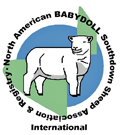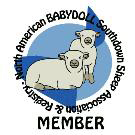| NORTH AMERICAN BABYDOLL SOUTHDOWN SHEEP ASSOCIATION & REGISTRY | ||||
 |
 |
 |
 |
 |
| Start your day with a SMILE...Own a BABYDOLL! | ||||
| NORTH AMERICAN BABYDOLL SOUTHDOWN SHEEP ASSOCIATION & REGISTRY | ||||
 |
 |
 |
 |
 |
| Start your day with a SMILE...Own a BABYDOLL! | ||||
The testing laboratories listed in the ACCREDITED TESTING LABORATORIES tab will have a procedure for submittal of required testing. If a member is uncertain about performing blood draws by themself they are encouraged to consult a veterinarian.
Please read all requirements of the testing laboratory chosen to avoid having to do another blood draw of your sheep.
The process does require a blood draw from each sheep being tested. Each vile will contain approximately 3 to 5 ml of blood, the sheep scrapie ID number will be used on the vile to identify each animal for testing. Please be sure each animal has a ID on the vile. The description of the vile (e.g., red cap) is important and some labs are very specific. Consult the procedures for the testing lab being used. It is advised, as well, to note laboratory storage and shipping requirements as some require cold pack containers, others accept expedited shipping within a specified time.
The animal's scrapie tag will identify the animal being tested and your final report results will note each animal and the results of the diseases being tested.
Example: SEROLOGY results will be reported as one line item on your report for CL, Q-Fever, and Brucellosis, your results should say something like NOT DETECTED, or NEGATIVE / DETECTED or POSITIVE. JOHNE'S is a separate line item on your report, and should say NEGATIVE or POSITIVE. OPP is a separate line item on your report, and should say NEGATIVE or POSITIVE.If a sheep does test positive on any of the results, it is recommended to test only those sheep again in 30 days to ensure the results were not a false positive.
The lab will issue a case number for the sheep being tested and the results, should questions arise regarding your results, it is advised to reference the case number for an expedited response from the testing laboratory.
If your preferred veterinarian is performing the blood draw, they and their staff already understand the process, and mailing requirements for the laboratory. Some veterinarians charge farm visit fees to your farm. If able, bringing the sheep to the clinic can reduce the cost of the vet fees. Be sure, before your veterinarian comes to your farm, your sheep are contained and one animal at a time is presented to the veterinarian to expedite the blood draw process. Making it more efficient for your veterinarian can save time, money, and avoid confusion with the sampling.
After a member has made
sure they've met all the requirements of the percentage reimbursement
program, and they've received their testing results, mail your paid
invoice/receipt AND the animal
testing results with all information intact to: